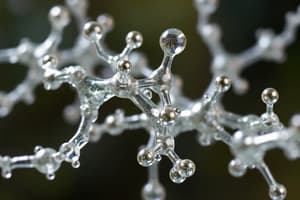Podcast
Questions and Answers
What are enzymes primarily made of?
What are enzymes primarily made of?
- Lipids
- Carbohydrates
- Nucleic acids
- Proteins (correct)
Enzymes are made by non-living organisms.
Enzymes are made by non-living organisms.
False (B)
What shape do enzymes have?
What shape do enzymes have?
Specific shapes (3D)
Do each chemical reactions have a specific enzyme?
Do each chemical reactions have a specific enzyme?
Enzymes are permanently changed after reactions.
Enzymes are permanently changed after reactions.
What do enzymes do in relation to activation energy?
What do enzymes do in relation to activation energy?
Enzymes can only exist in an active form.
Enzymes can only exist in an active form.
Some enzymes require cofactors to become active.
Some enzymes require cofactors to become active.
What is activation energy?
What is activation energy?
What type of reactions does oxidoreductase catalyze?
What type of reactions does oxidoreductase catalyze?
What does transferase do?
What does transferase do?
What type of reaction is catalyzed by hydrolases?
What type of reaction is catalyzed by hydrolases?
What do lyases do?
What do lyases do?
What is the function of isomerase?
What is the function of isomerase?
What does ligase do?
What does ligase do?
What factors affect enzyme activity?
What factors affect enzyme activity?
What type of inhibitor competes with the normal substrate for the active site?
What type of inhibitor competes with the normal substrate for the active site?
What is a non-competitive inhibitor also known as?
What is a non-competitive inhibitor also known as?
What do feedback inhibitors do?
What do feedback inhibitors do?
What is an apoenzyme?
What is an apoenzyme?
Match the following enzyme types with their functions:
Match the following enzyme types with their functions:
What regulates enzyme synthesis and activity?
What regulates enzyme synthesis and activity?
Study Notes
Enzyme Characteristics
- Enzymes are primarily proteins, serving as biological catalysts.
- Produced by living organisms, enzymes play vital roles in biochemical reactions.
- Enzymes possess specific three-dimensional shapes, which makes them larger than their substrates.
- Each type of chemical reaction is associated with a specific enzyme, ensuring efficiency and specificity.
- Enzymes are not consumed or permanently altered during reactions, allowing them to be reused.
- They catalyze reactions by lowering the activation energy required, speeding up the process.
Enzyme Forms and Activation
- Enzymes can exist in both active and inactive forms within a cell, allowing for regulation.
- Some enzymes require cofactors (non-protein molecules) to achieve their active form, integral to their function.
Activation Energy
- Activation energy is the minimum energy required for a chemical reaction to occur.
Enzyme Categories
- Oxidoreductase: Catalyze oxidation-reduction reactions.
- Transferase: Responsible for transferring functional groups between molecules.
- Hydrolase: Enzymes that facilitate hydrolysis reactions.
- Lyase: Remove atoms from molecules without the need for hydrolysis.
- Isomerase: Enzymes that catalyze the rearrangement of molecular structures.
- Ligase: Join two molecules together, utilizing ATP in the process.
Factors Affecting Enzyme Activity
- Temperature: Variation can enhance or inhibit enzyme activity based on optimal conditions.
- pH: Enzymes have specific pH ranges wherein they function best, and alterations can disrupt activity.
- Substrate Concentration: Similar to the analogy of workers building a brick wall, enzyme efficiency increases with the availability of substrates until a saturation point is reached.
Inhibitors of Enzyme Activity
- Inhibitors can reduce enzyme activity and are classified as:
- Competitive Inhibitors: Compete with the substrate for the active site and are characterized as aggressive.
- Non-competitive Inhibitors: Also known as allosteric inhibitors, they bind to parts of the enzyme other than the active site.
- Feedback Inhibitors: End-products of a metabolic pathway inhibit the initial step, helping regulate the pathway's flow.
Enzyme States and Regulation
- Apoenzyme: A form of an enzyme that is inactive, requiring a cofactor for activation.
- Cellular Control: Involves regulation of enzyme synthesis and activity to maintain metabolic balance and respond to cellular needs.
Studying That Suits You
Use AI to generate personalized quizzes and flashcards to suit your learning preferences.
Description
Explore the fascinating world of enzymes with this quiz covering their characteristics, forms, and roles in biochemical reactions. Understand how enzymes act as catalysts and their importance in lowering activation energy. Test your knowledge on enzyme categories and the regulatory mechanisms that govern their activity.




